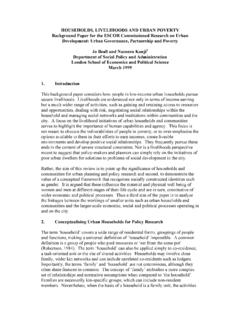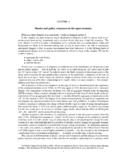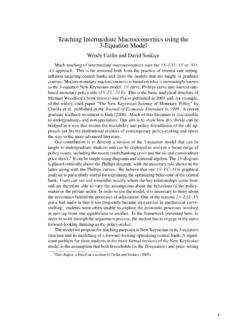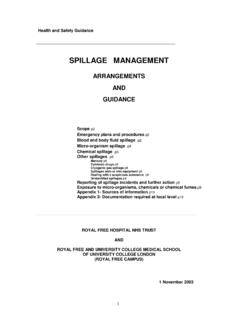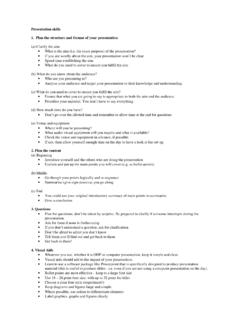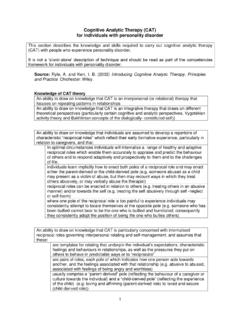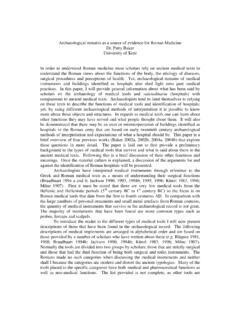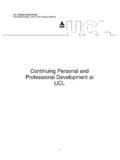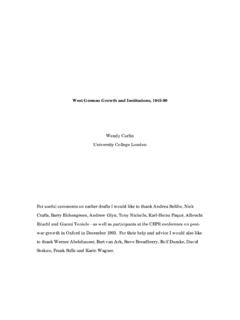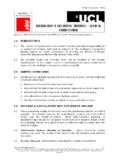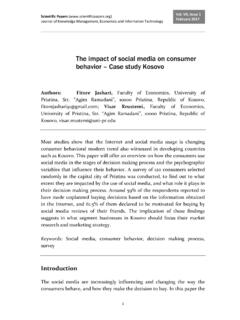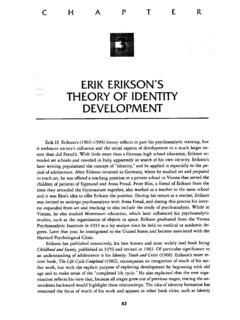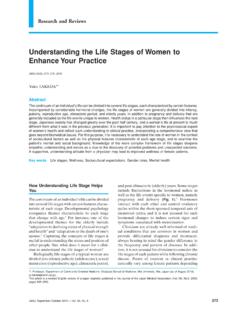Transcription of Social Phobia Heimberg/ Hope model - UCL
1 Problem-specific competences describe the knowledge and skills needed when applying CBT principles to specific conditions. They are not a stand-alone' description of competences, and should be read as part of the CBT competence framework. Effective delivery of problem-specific competences depends on their integration with the knowledge and skills set out in the other domains of the CBT competence framework. Social Phobia Heimberg/ Hope model Sources: Hope, , Heimberg, , & Turk, Cynthia, L. (2006) Managing Social anxiety: A cognitive- behavioural approach. Oxford: OUP. Heimberg and Becker, (2002) Cognitive-behavioral group therapy for Social Phobia . New York: Guilford Press Knowledge of the CBT model being applied Knowledge of the CBT model being employed, which indicates that in Social situations in which socially anxious individuals perceive the potential for negative evaluation: they will form a mental representation of themselves based on prior experience, current internal cues and cues based on their perceptions of the reactions of others they will continuously contrast this representation with their appraisal of the standard' they perceive their audience to expect they will preferentially allocate attention to monitor for evidence of any negative feedback they will predict a high likelihood of negative evaluation and react to any detected evidence of this with cognitive, behavioural and physiological symptoms of anxiety.
2 Which in turn will feed back into their mental representation in subsequent Social situations Engagement and assessment Establishing a working relationship A capacity to recognise the problems associated with Social anxiety that could adversely influence or inhibit the development of a therapeutic relationship A capacity to adapt therapeutic style to manage client's interpersonal difficulties and excessive self-consciousness ( using strategies such as reducing eye gaze, modulating Social distance etc). 1. Assessment of Social anxiety An ability to conduct a thorough assessment of the client's difficulties, combining information from interview and relevant instruments in order to confirm a diagnosis of Social anxiety An ability to clarify the primacy of Social Phobia to other co-existing problems or psychological disorders, and to determine appropriate intervention plans in relation to comorbidity. An ability to use measures to aid evaluation of the full clinical picture and to gain a pre-treatment baseline Awareness of the potential impact of shame and anxiety on information given in the initial assessment, and an ability to supplement information from the interview with measures An ability to devise and carry out a pre-treatment behaviour test as part of the assessment Intervention General considerations An ability to be comfortable with, and to manage, manifestations of high levels of anxiety (including anger in response to perceived threat).
3 An ability to identify when clients are struggling with aspects of the intervention, to address the problem and if appropriate to adapt the intervention appropriately to meet the client's needs An ability to integrate the main elements of the intervention (exposure and cognitive restructuring), and to implement treatment in a manner which is structured but responsive to the needs of the individual client Psychoeducation An ability to help the client conceptualise their own Social anxiety in the context of the CBT model (the primacy of cognition, negative consequences of avoidance and habituation). An ability to provide an overview of the treatment model , particularly its emphasis on the active role of the client in applying their coping skills through homework tasks An ability to help the client conceptualise their difficulties in the context of the treatment model , but also to acknowledge ways in which the client's perspective differs from this model An ability to present a biopsychosocial model of aetiology which acknowledges the role of genetics and early experience, but which emphasises the role of information processing biases in generating Social anxiety and avoidance An ability to link the model to the major components of treatment (exposure, cognitive restructuring and homework tasks).
4 2. An ability to assess the client's perception of the credibility of therapy, and to discuss these if there is an indication that the clients' perceptions are likely to impact on engagement ( if the therapy is viewed sceptically or over- enthusiastically). Establishing a hierarchy of feared situations An ability to help the client construct a hierarchy of feared and avoided Social situations by working with the client to: brainstorm a list of feared and avoided Social situations in order to ensure that all potentially relevant situations are included identify a shortlist of approximately 10 situations that are representative of the client's current difficulties, and which range from mildly to more severely anxiety provoking rank order the situations identify the dimensions that make the situations easier or harder to manage ( characteristics of other persons present, or the nature of the situation). rate the degree of fear and avoidance for each situation using SUDS.
5 (Subjective Units of Discomfort Scale). Self-monitoring An ability to help clients begin self-monitoring of their Social anxiety and mood, using in-session practice to check that the client understands the procedure, that they understand the rationale for monitoring, and to identify and troubleshoot'. any potential barriers to monitoring An ability consistently to review the self-monitoring across and within all sessions Where the client has difficulty in self-monitoring, an ability to help them identify and resolve any issues which make self-monitoring problematic Cognitive Restructuring An ability to explain the concept of automatic thoughts and to offer appropriate illustrative examples, with the aim of helping the client identify that it is not the event itself which creates anxiety, but their interpretation of that event An ability to discuss the concept of cognitive restructuring with the client, with the aim of helping the client to understand this as an opportunity to appraise the validity of their thoughts, rather than to see these thoughts as wrong'.
6 An ability to help clients identify and self-monitor automatic thoughts, and to make links between these and the emotions, behavioural and physiological reactions they give rise to An ability to help clients who find it difficult to access automatic thoughts, using strategies such as review of specific situations, or helping them to translate of images of situations into verbal statements 3. An ability to help clients challenge automatic thoughts by: explaining the concept of information processing biases and offering illustrative examples helping the client to consider these biases in relation to their own automatic thoughts making systematic use of Disputing Questions ( what evidence do I. have that , do I know for certain that etc) to appraise the validity of their automatic thoughts generating phrases or statements that summarise the most important points made when challenging specific automatic thoughts ( rational responses').
7 Exposure An ability to conduct an initial in-session exposure by working with the client to: choose an appropriate situation, fixing an appropriate duration for the exposure and ensuring that the exposure is carried out identify and agree achievable behaviour goals for the role play identify automatic thoughts and using cognitive restructuring make ratings of SUDS during and after the exposure An ability to debrief after exposure, ensuring that the client's perceptions are thoroughly explored An ability to provide feedback on the exposure task in a constructive manner which is both accurate and honest, and which focuses on contrasting the client's actual performance with their prior beliefs An ability to help the client summarise what they have learnt from the exposure that can be applied to future situations An ability to plan appropriate in-session exposures An ability (where appropriate) to make use of external role players (which will involve briefing the client and giving guidance to role-players regarding their feedback to the client).
8 With clients who refuse or avoid exposure, an ability to explore their concerns and to develop a plan for proceeding which accommodates these Where clients react catastrophically to a completed exposure exercise, an ability to help them appraise their perceptions of the experience An ability to agree and to assign self-exposure homework which explicitly includes the three elements of exposure, self- monitoring and cognitive restructuring An ability to work with the client to design effective exposure tasks for specific manifestations of Social anxiety ( signing name in public, eating or drinking in public, fear of using public toilets), incorporating the feared outcome where a loss of control or fear of humiliation is a significant part of the anxiety 4. An ability to help the client focus on automatic thoughts prior to exposure in a graduated manner (usually starting with situationally-based performance-related thoughts, at later stages considering thoughts related to negative self-evaluation).
9 An ability to review homework tasks, and to explore and resolve any difficulties the client has in completing these tasks Addressing core beliefs An ability, usually at later stages of therapy, to identify core beliefs and to discuss with the client the ways in which these beliefs may generate and/or maintain their Social anxiety An ability to help the client unpack' the meaning of emotionally loaded words (such as perfect' right' best') in order to identify core beliefs An ability to challenge core beliefs using cognitive restructuring and exposure Ending therapy and planning for relapse prevention An ability to assess overall progress, and to make decisions about further treatment based on measures and client self-monitoring forms An ability explicitly to discuss the issue of relapse, and to help clients consider how they can employ the skills they have learned after treatment ends An ability to acknowledge client's feelings about losing therapist contact 5.
